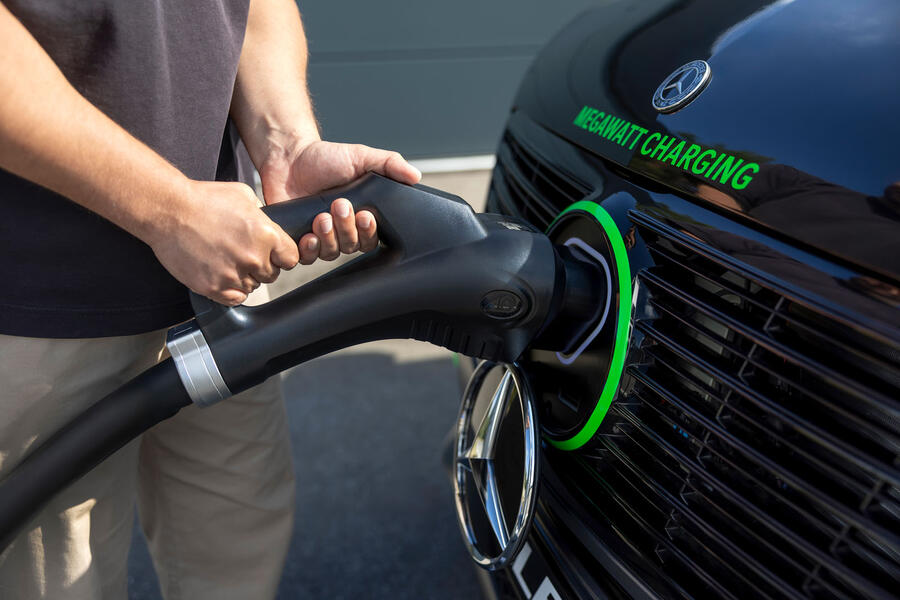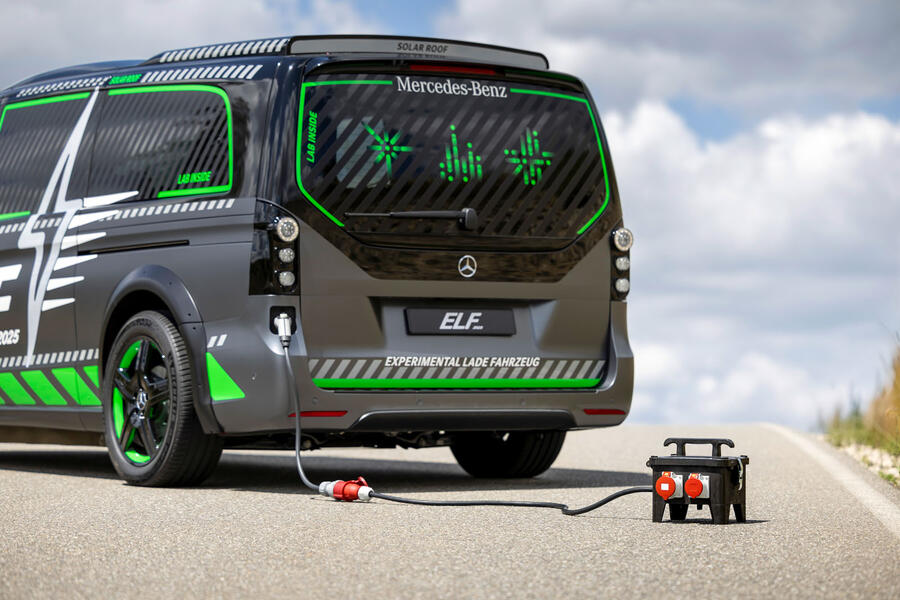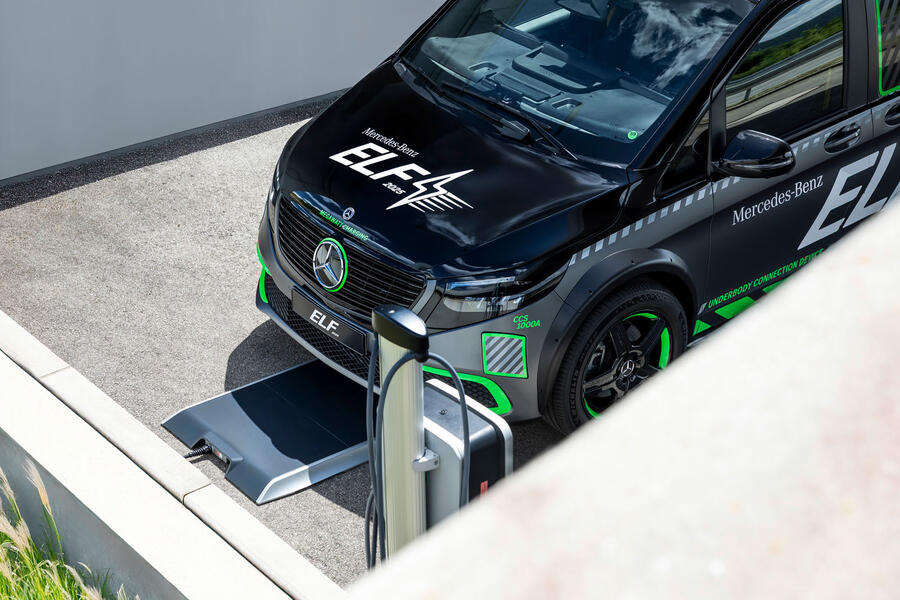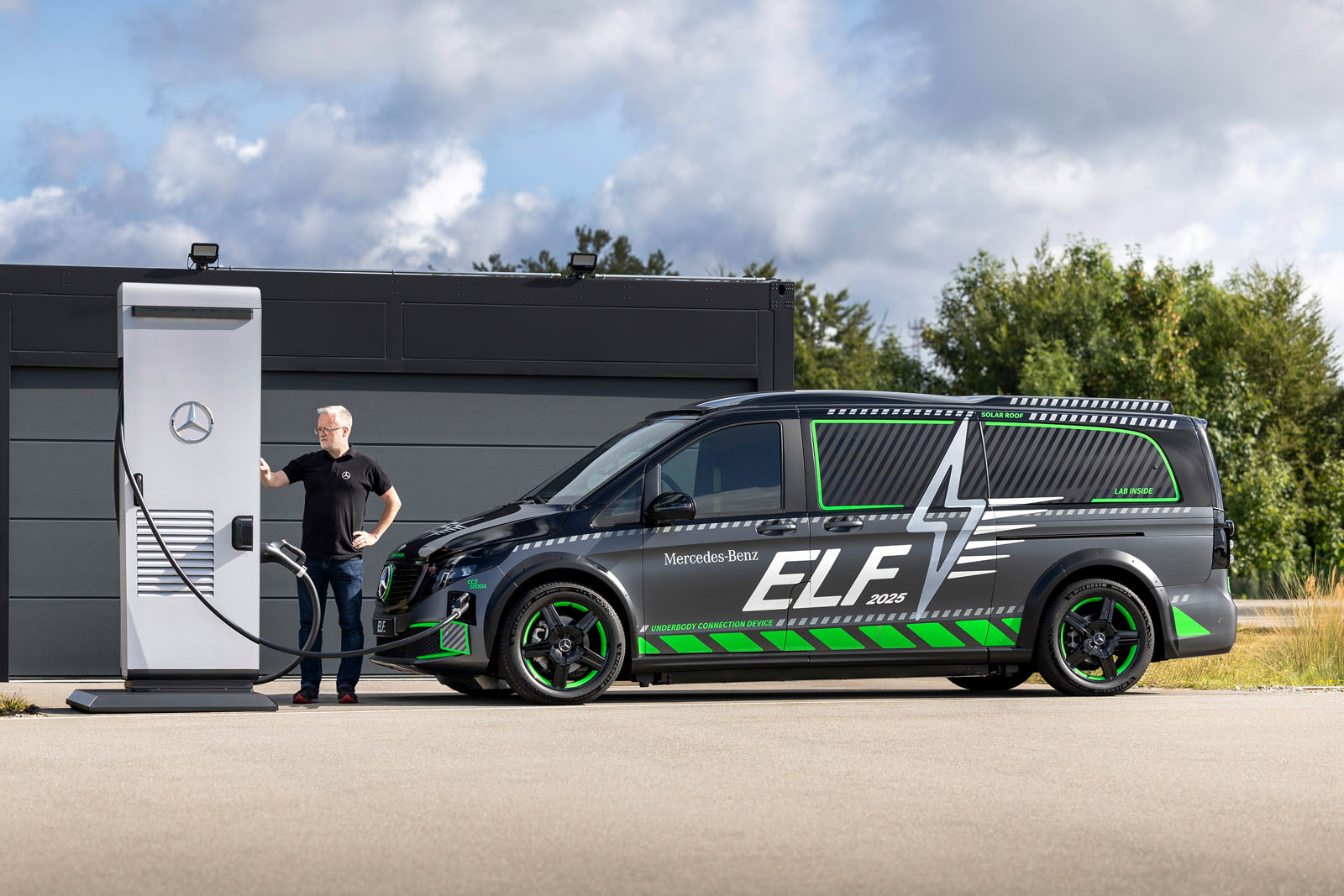Mercedes-Benz is targeting one of the final barriers to what it sees as widespread electric car adoption by making the time it takes to charge as quick and convenient as filling up at a fuel station.
At the centre of this push is an advanced rolling laboratory known as the Experimental-Lade-Fahrzeug (‘Experimental Charging Car’), or ELF for short. Based on a V-Class, it has five different charging ports and serves as a fully mobile research hub designed to explore the outer limits of charging technology – from extreme electric energy transfer and battery cooling to bidirectional energy flow, automated inductive and conductive charging, solar charging and more.
The push for increased charging speeds has become the main focus, as Mercedes believes the challenge of range has already been largely overcome. Its latest electric models, such as the CLA EQ saloon, come close to 500 miles, a figure that puts them within striking distance of diesel cars for outright range.
“The next battle is about convenience,” said Malte Sievers, Mercedes’ head of charging development. “Customers want charging to be as quick, seamless and effortless as refuelling. That’s where our work with ELF is focused.”
The ELF is equipped with two types of cable-based charging systems: a dual-port Combined Charging System (CCS) and a heavy-duty Megawatt Charging System (MCS).
The CCS uses ports on either side of the front bumper and is designed to push production-ready components to their limits.
Mercedes says the ELF is capable of hitting up to 900kW – enough to add 100kWh of electricity in around 10 minutes at a current of up to 1000 amps. That’s roughly three times the capacity of the new GLC EQ.
The MCS system, derived from electric truck technology, takes things further still. Plugging into a port behind the three-pointed star in the centre of the grille, it subjects the battery to loads above 1000kW to test thermal resilience under heavy charging conditions.
View all car reviews
Electric version of V-Class seeks to deliver an even more luxurious service to wealthy passengers
Developments tested on the ELF are already influencing Mercedes’ production plans.
Research from its dual CCS/MCS system directly influenced the charging architecture of the Mercedes-AMG GT XX concept, which achieved a peak charging power of 1041kW during a record-setting endurance run at the Nardò test track in August.
To achieve this, Mercedes partnered with Italian charging specialist Alpitronic to modify a commercial truck charger capable of delivering more than 3000kW. This prototype unit is a precursor to the next generation of ultra-high-capacity chargers that Mercedes plans to introduce.
Bidirectional charging is another area of major focus. This technology enables an EV to supply power to a home (vehicle-to-home), feed electricity back into the grid (vehicle-to-grid) or run appliances such as tools or outdoor equipment (vehicle-to-load).
The ELF supports both AC and DC bidirectional systems, and production readiness is already advancing.
From 2026, Mercedes will offer MB Charge Home in the UK – a bundled wallbox and energy management service that allows owners to use their EV batteries as home power storage.
Mercedes estimates that a typical electric car could supply a household with power for several days, potentially cutting annual energy bills by around £435.
Mercedes’ long-term ambition extends even further than pure charging speed. It’s developing a “virtual energy account” that would allow customers to earn energy credits by feeding power from their EVs back into the grid.
This would help grid stability during periods of peak demand. To manage this, Mercedes is developing its own software capable of coordinating thousands of cars as a single “virtual power plant”.
Earned credits could be used to make future charging sessions cheaper. The aim is turn the car into a flexible, portable energy bank.
The ELF is also being used to develop a range of future charging methods. It’s equipped with an inductive charging system capable of transferring 11kW wirelessly via an electromagnetic field between coils on the ground and on the vehicle.
Similar to what is offered on the new Porsche Cayenne Electric, this system is ideal for what Sievers calls “snack charging” during short stops.
Mercedes is also working on automated conductive charging, where a connector rises from the ground.
For high-power applications, robotic systems capable of connecting the charging cable automatically are also undergoing testing.
A further development on the ELF is a photovoltaic roof, which consists of monocrystalline silicon cells that feed power to the battery.
While not intended as a primary charging source, it can add up to 19 miles of range per day under ideal sunny conditions – sufficient, says Sievers, to offset typical standby power loss or slowly build range while the car is parked. It’s a similar system to what was used by the Fisker Ocean.
All of these developments tie directly into Mercedes’ expanding global charging network, which aims to make DC fast charging as accessible as petrol refuelling.
Lessons learned from the ELF project are already helping shaping the electric car charging technology of the future – as shown by the AMG GT XX concept.
According to Sievers, this makes the once far-fetched idea of a five-minute charging stop and a 500-mile refill (100 miles a minute) a realistic prospect for production EVs before the end of the decade.
According to Sievers, this makes the once far-fetched idea of a five-minute charging stop and a 500-mile refill (100 miles a minute) a realistic prospect for production EVs before the end of the decade.
Join our WhatsApp community and be the first to read about the latest news and reviews wowing the car world. Our community is the best, easiest and most direct place to tap into the minds of Autocar, and if you join you’ll also be treated to unique WhatsApp content. You can leave at any time after joining – check our full privacy policy here.
While nothing is said in the article, or any images of it in the pictures provided, what about recharging in the cold or where is heavy snow? Charging an EV takes more time, as the batteries themselves need to be preconditioned. While recharging during the heat of a sunny day has its own challenges, a ten or 20 minute refill in the cold and snow is nothing to look forward to either.
..a ten or 20 minute refill in the cold and snow is nothing to look forward to either.
and a ten minute petrol refil on the Tesco’s forecourt in the snow of course is something to look forward to? But neither beats refueling at home, if you’ve a petrol pump on your driveway that is.
Another thing not to look forward to is 15 minutes defrosting an ICE car in winter opposed to getting in a defrosted pre-warmed BEV.
Cool project from Mercedes! Charging cars this fast sounds amazing.
gtu
View all car reviews











